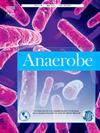Characterization of Lachnoanaerobaculum sanguinis sp. nov., isolated from a blood culture of an acute myeloid leukemia patient with chemotherapy-related bacteremia
IF 2.6
3区 生物学
Q3 MICROBIOLOGY
引用次数: 0
Abstract
Objective
This study was to characterize and determine the classification of the novel strain TM49T, isolated from a blood culture of a patient who developed bacteremia while receiving high-dose cytarabine chemotherapy for acute myeloid leukemia.
Methods
The novel strain TM49T was characterized at the species level through a polyphasic taxonomic analysis, incorporating morphological, physiological, biochemical, phylogenetic, and genome sequence analyses.
Results
16S rRNA gene sequence analysis revealed that the strain belonged to the genus Lachnoanaerobaculum. The 16S rRNA gene sequence of strain TM49T was observed to be most similar to that of "Lachnoanaerobaculum gingivalis" strain ChDC B114T (99.2 %). Strain TM49T formed circular, glossy, slightly milky colonies with an undulate margin on BD™ Columbia Agar containing 5 % sheep blood after 48 h at 37 °C, exhibiting less spreading compared to species of the genus Lachnoanaerobaculum. The major fatty acids of strain TM49T were C16:0, C14:0, C18:1 ω9c DMA, and C18:1 ω7c DMA. The draft genome sequence of strain TM49T was 2,821,554 bp in length, with a G + C content of 36.4. Digital DNA-DNA hybridization values between strain TM49T and “L. gingivalis” ChDC B114T, L. umeaense CD3: 22T, L. orale N1T, and L. saburreum CCUG 28089T were 52.2 %, 29.7 %, 26.2 %, and 24.5 %, respectively. The Orthologous Average Nucleotide Identity values between strain TM49T and “L. gingivalis” ChDC B114T, L. umeaense CD3: 22T, L. orale N1T, and L. saburreum CCUG 28089T were 93.1 %, 84.9 %, 83.2 %, and 81.5 %, respectively.
Conclusion
Strain TM49T (JCM 36186T = DSM 116945T) was found to be distinct from previously described species of the genus Lachnoanaerobaculum. Therefore, it is proposed as a new species, Lachnoanaerobaculum sanguinis sp. Nov., with strain TM49T as the type strain (= JCM 36186T = DSM 116945T).
急性髓系白血病伴化疗相关菌血症患者血培养分离的血氧厌氧菌的特征
目的:对一名急性髓系白血病患者在接受高剂量阿糖胞苷化疗时发生菌血症的血培养株TM49T进行鉴定并确定其分类。方法采用形态学、生理生化、系统发育和基因组序列分析等多相分类学方法对新菌株TM49T进行种水平的鉴定。结果16s rRNA基因序列分析表明该菌株属于厌氧藻属。菌株TM49T的16S rRNA基因序列与“牙龈厌氧菌”菌株ChDC B114T最相似(99.2%)。菌株TM49T在含有5%羊血的BD™Columbia琼脂上,在37℃下培养48小时后形成圆形、光滑、微乳状、边缘呈波状的菌落,与Lachnoanaerobaculum属的菌种相比,菌落扩散较少。菌株TM49T的主要脂肪酸为C16:0、C14:0、C18:1 ω9c DMA和C18:1 ω7c DMA。菌株TM49T的基因组草图序列长度为2821554 bp, G + C含量为36.4。菌株TM49T与“L”的数字dna杂交值。牙龈菌ChDC B114T、牙龈菌CD3: 22T、口腔菌N1T、saburreum菌CCUG 28089T分别为52.2%、29.7%、26.2%和24.5%。菌株TM49T与“L”的同源平均核苷酸同源性。齿龈菌ChDC B114T、牙牙菌CD3: 22T、口腔菌N1T和saburreum CCUG 28089T分别为93.1%、84.9%、83.2%和81.5%。结论菌株TM49T (JCM 36186T = DSM 116945T)与Lachnoanaerobaculum属不同。因此,本文提出以菌株TM49T为型菌株(= JCM 36186T = DSM 116945T),作为新种Lachnoanaerobaculum sanguinis sp. Nov.。
本文章由计算机程序翻译,如有差异,请以英文原文为准。
求助全文
约1分钟内获得全文
求助全文
来源期刊

Anaerobe
生物-微生物学
CiteScore
5.20
自引率
8.70%
发文量
137
审稿时长
76 days
期刊介绍:
Anaerobe is essential reading for those who wish to remain at the forefront of discoveries relating to life processes of strictly anaerobes. The journal is multi-disciplinary, and provides a unique forum for those investigating anaerobic organisms that cause infections in humans and animals, as well as anaerobes that play roles in microbiomes or environmental processes.
Anaerobe publishes reviews, mini reviews, original research articles, notes and case reports. Relevant topics fall into the broad categories of anaerobes in human and animal diseases, anaerobes in the microbiome, anaerobes in the environment, diagnosis of anaerobes in clinical microbiology laboratories, molecular biology, genetics, pathogenesis, toxins and antibiotic susceptibility of anaerobic bacteria.
 求助内容:
求助内容: 应助结果提醒方式:
应助结果提醒方式:


